Sustainability Indicators to Assess Infrastructure Projects: Sector Disclosure to Interlock With the Global Reporting Initiative
Publications
Engineering Journal
Bangkok – Thailand – 2020
Abstract
Infrastructure projects have great potential to impact the sustainability of cities due to typically being large-sized projects and having a high level of intervention. Thus, evaluating the sustainability of these projects through sustainability reports is highly relevant, mainly regarding their impacts on the environment, public health, and the local economy. The Global Reporting Initiative (GRI) is the most widespread and internationally accepted Sustainability report tool. However, the GRI does not have an infrastructure sector disclosure. This research addresses this gap by providing a sustainability assessment instrument for infrastructure projects that interlocks with the Global Reporting Initiative (GRI). An extensive and detailed literature review was conducted, identifying 97 potential indicators to measure the sustainability of infrastructure projects. These indicators were evaluated following a top-down approach, conducting a survey of professionals experienced in the relevant field using Lawshe’s content validity ratio. The results showed that 42 indicators were validated as essential, with 21 of them, not specifically related to infrastructure projects, already covered by the standard disclosure of the GRI. This assessment enabled the proposal of a sector disclosure formed by 21 new indicators related to the environmental, economic, and social dimensions. This study closes a gap in the evaluation of the sustainability of infrastructure projects and contributes to the discussion about sustainability indicators in infrastructure projects.
1 . Introduction
The necessity of measuring the sustainability of infrastructure projects has aroused the interest of researchers, as well as governmental and intergovernmental organizations. A significant part of the infrastructures built in several countries demanded large investments [1] and was later classified as unsustainable, because of their harmful effects on the population, fauna, flora, landscape, climate, water, and cultural heritage—this demands evaluation [2].
Many classifications can be adopted for the construction industry; however, in general, it is composed of three subsectors: building, industry, and infrastructure, involving, primarily, construction activities, reconstruction, alteration, repair, and demolition. The products from the “building subsector” are residential and commercial buildings. The products from the “industrial subsector” are factories, refineries, etc. The products from the “infrastructure subsector” are great works of engineering, typically public ones related to transport (roads, bridges, busways, cycleways, footpaths, railways), water (sewage, drainage, water storage, supply), energy (transmission and distribution), communication (transmission and distribution), sanitation, utilities, facilities, and others [3-5].
Despite being a precondition for industrialization and economic development [6,7], impacts caused by infrastructure projects have been cited in several studies, such as new roadways and railway lines—that increase noise pollution [8] and affect the mobility and well-being of communities [9,10] —and dams—that are among the most impactful stressors that affect aquatic ecosystems [11].
Infrastructure projects are typically characterized by large extension, broader and more varied potential impacts [3], and “significant impact on the sustainable construction environment” [12]. These features combined make infrastructure projects have a “great impact on urban and overall project management, mostly because of the large zones of influence” [13].
Sahely et al. [14] stated that massive urban growth had taken place in the previous few decades and that infrastructure projects are crucial to urban sustainability. According to Shen et al. [15], infrastructure projects are vital to the economy of a country but can also cause negative environmental and social impacts.
The construction industry is estimated to account for about 40% of global energy use, as well as 20% of water consumption and 40% of global carbon emissions [16]. In the civil construction sector, infrastructure projects account for a considerable portion of this impact. Statistical data show that there is a correlation between these impacts and the deaths of children under five years of age in developing countries, where 15% die from contaminated water, 36% from infectious respiratory diseases and 22% from chronic lung diseases caused by pollution from dust particles [3].
Thus, infrastructure projects directly impact not only the environment, but also public health, community well-being, the economies of surrounding cities and regions, and urban sustainability [13], reinforcing the demand for indicators of infrastructure project sustainability [12].
Ugwu et al. [13] claim that infrastructure sustainability indicators have a key role in evaluating infrastructure sustainability and stakeholder education. In this context, many infrastructure sustainability indicators and infrastructure indicator frameworks emerged. These frameworks relate indicators, forming a global index [15-20].
However, there is still plenty of scope for improvement in infrastructure project sustainability indicators, mainly concerning relating infrastructure project sustainability to social and economic dimensions, by aligning project sustainability measurement with the Triple Bottom Line model [5, 19,21,22]. One of the biggest problems in evaluating sustainability lies in the identification of sustainability indicators and the selection of the most important indicators [23].
From extensive and detailed bibliographical research, we identified seven infrastructure sustainability indicator lists proposed by researchers [12-15, 17-20]. In general, these lists were generated from case studies, surveys, and governmental guidelines.
Sahely, Kennedy, and Adams [14] state that urban growth has taken place in the last few decades and that infrastructure projects are crucial to urban sustainability. The authors proposed 34 social, economic, environmental, and constructive indicators in a study case conducted in Toronto.
Ugwu, Kumaraswamy, Wong, and Ng [13] claim that infrastructure sustainability indicators have a key role in contributing to the reflection on infrastructure sustainability and the education of stakeholders. The authors used an instrument formulated through a lengthy interview process, study case data, and governmental guidelines. Based on 134 Hong Kong respondents, the result is a model containing 55 indicators.
Ugwu and Haupt [12] highlight the international and urgent demand for measuring infrastructure projects’ sustainability. The authors applied Ugwu, Kumaraswamy, Wong, and Ng’s [8] indicators in South Africa with little adaptation and including few indicators, resulting in 61 infrastructure sustainability indicators.
Koo, Ariaratnam, and Kavazanjian [24] propose an underground infrastructure sustainability assessment model that emphasizes the social, economic, and environmental dimensions. The authors used the AHP method and an instrument consisting of 47 indicators to enable more sustainable decision making in infrastructure projects.
Shen, Wu, and Zhang [15] reinforce the suggestion that infrastructure projects are vital to the economy of a country but also cause adverse environmental and social impacts. The authors, based on a bibliographical review, propose an instrument consisting of 30 indicators applied in a case study in the Chinese construction industry.
Ariaratnam, Piratla, Cohen, and Olson [18] investigate the social, environmental, and economic impacts of underground infrastructure projects, comparing four underground construction techniques and using 13 sustainability indicators to measure these impacts.
Boz and El-adaway [19] affirm that there is little agreement among stakeholders on what sustainability is and how to measure it. They use a methodology based on expert knowledge and propose a model of sustainability indicators for infrastructure projects containing 22 indicators combining “work” and “nature”.
Other researchers have published research about civil construction sustainability indicators in the last few years [15, 22-25]. Some researchers focus on specific infrastructure sustainability indicators, including energy and electricity infrastructure projects [26, 27], transport infrastructure projects [28], rail trains [29], and water supply systems [30].
We also find four infrastructure sustainability indicators proposed by organizations and governments: ASPIRE [31], CEEQUAL [32], ENVISION [33], and GRI Real Estate Sector Disclosure [34].
ASPIRE (A Sustainability, Poverty, and Infrastructure Routine for Evaluation) is a model designed by Engineers Against Poverty in partnership with the multinational Arup Group Limited and is structured around four main themes: environment, society, economy, and institutions. Each theme is subdivided into sub-themes, which in practice are sustainability indicators for each theme, totaling 97 indicators.
CEEQUAL (Civil Engineering Environmental Quality Assessment and Award Scheme) is a model that proposes indicators related to twelve areas: project management, land use, landscape issues, ecology and biodiversity, historic environment, water resources and the water environment, energy and carbon, material use, waste management, transport effects on neighbors, and relations with the local community and other stakeholders. The model proposes 241 indicators, where each indicator contributes scores that are linked to summarize the project practices and sustainability consciousness level.
ENVISION was developed by the Institute for Sustainable Infrastructure and engages five categories: quality of life, leadership, resource allocation, natural world and climate, and risk. Each category contains themes, and each indicator addresses issues related to project governance and the resilience of infrastructure projects, aiming to contribute to more resilient and long-term sustainable projects. ENVISION contains 182 indicators.
The GRI sector disclosure for construction and real estate encompasses infrastructure projects, although the disclosure must be used with standard disclosures. The disclosure is aligned with the Triple Bottom Line framework, following the GRI standard. It consists of four areas (economic, environmental, social, and construction and real estate) and 47 indicators
By analyzing the lists of indicators and models, the predominance of indicators focused on the environmental aspect is evident. This characteristic has been observed in most of the listings produced by researchers, and the list compiled by Ugwu and Haupt [12] contains the highest number of indicators related to social and economic aspects: eight indicators out of 61. Regarding the models, we noted that ASPIRE and the GRI Real State Sector Disclosure align more clearly with the Triple Bottom Line model, while the CEEQUAL and ENVISION again tend to emphasize environmental indicators.
Another observation is the difficulty of focusing on only a few indicators due to the large nature of infrastructure projects. The CEEQUAL model lists 241 indicators, and Ariaratnam et al. [18] and Boz and El-adaway [19] presented the lowest number of indicators, 13 and 22, respectively.
Also, there is an increasing demand for corporate and governmental accountability. Corporations and governments are compelled by society to be transparent about the sustainability of their industrial and managerial activities [35-39]. It is precisely at the point of confluence of the growing need for “accountability” and the holistic concept of sustainability that sustainability reporting models have emerged in the last few decades [40-42].
Sustainability reporting models provide a framework of indicators that facilitates corporate and governmental accountability reports for stakeholders regarding the sustainability of projects [39-41]. Their use has focused mainly on informing the decision-making process of external stakeholders, legitimation, reputational enhancement, and marketing [45].
Studies aiming at the development and improvement of sustainability reports for the private sector have received more attention from researchers [46]. Among these sustainability reporting models, the most widespread and widely accepted internationally is the Global Reporting Initiative (GRI), which is based on the Triple Bottom Line framework and thus encompasses the social, economic, and environmental dimensions of sustainability [47-48]. The GRI provides a standard disclosure format and some sectoral disclosures with indicators for specific sectors [48]. The development of indicators for specific sectors is arousing interest among many researchers [49-52].
The GRI sustainability reporting model consists of two parts: reporting principles and standard disclosures. The reporting principles are accuracy, timeliness, clarity, and reliability. The standard disclosures are divided into general standard disclosures—organizational identity, strategy, stakeholders, and governance—and specific standard disclosures, which include 91 sustainability indicators covering the social, economic, and environmental dimensions [53].
In addition to providing standard disclosures, the GRI contains sustainability reporting models with indicators related to specific sectors, such as the media, airport operation, electric utilities, event organization, financial services, food processing, mining and metals, non-governmental organizations, and oil and gas. The GRI also has a sector disclosure for construction and real estate, the indicators of which are geared towards the construction of buildings. This disclosure sector consists of 47 indicators, of which some are relevant to infrastructure projects, not including specific project indicators of such nature, such as those relating to the water pollution control plan, noise pollution, toxic waste, access to potable water and sanitation services, drainage systems, preservation of historical and archaeological sites, disaster risks, climate change risks, flood risk during site selection, and soil conservation and restoration. Not having a specific sector for infrastructure projects is surprising, considering the potential impacts of these projects on sustainability, particularly on public health [13, 15], worker health [15], environmental health [19], local economies [18], and both public [12-13, 18] and worker safety [24].
Siew et al. [5] conducted a wide-ranging global review of existing models to assess infrastructure project sustainability, concluding that “There is a need to bridge the current gap and look at avenues by which building/infrastructure SRTs can interlock with GRI”. Therefore, there is a demand for an instrument to measure the sustainability of infrastructure projects that intentionally involves and relates environmental, social, and economic aspects, following the GRI sectorial content standard.
Furthermore, international bodies, including the United Nations (UN) through the Commission on Sustainable Development, started a research agenda centered on sustainability indicators to facilitate a more measurable discussion of sustainability [43]. This intentional stimulus has led to an accelerated growth of sustainability indicators and models that reconcile indicators, relating them to form a global index, with many of these models being sector-specific [14]. One sector in which the number of indicators and modeling of sustainability indicators is increasing is the infrastructure sector [5].
However, the substantial increase in the number of infrastructure sustainability indicators introduces the risk that it might become too extensive. Also, there are no reports that identify the indicators that must be included in the GRI to improve aspects related to the environmental, social, and economic sustainability dimensions of infrastructure projects.
This study addresses this gap and contributes to the literature handling indicators for the evaluation of infrastructure projects by identifying the indicators considered most important by researchers who publish on the topic, from extensive and detailed bibliographic research. It distinguishes what can be regarded as essential, according to the professionals who work in this field.
Considering the importance of the GRI project sustainability reports in international sustainability assessment, this paper also contributes to the evaluation of infrastructure project sustainability, proposing a GRI infrastructure sector disclosure.
In construction, most studies are geared towards reducing the impacts of building works, so this article also contributes to the sustainable planning and the evaluation of the impacts of a less explored sector—the infrastructure sector.
2. Materials and Methods
2.1. General Approach
Although the GRI is a structure mainly used for organizational reports, some sector contents include specific projects, such as, for example, Construction and Real Estate Sector Disclosure, in this article, we propose specific sector disclosure for infrastructure projects to improve the sustainability assessment of these projects. The strategy adopted was to use only indicators of articles with a specific focus on infrastructure projects. We consider that the fact that these researchers work on the theme establishes a first important filter on the applicability and importance of the indicator and, therefore, from the experience of these authors, we have a set of indicators more relevant, representative and specifically focused on infrastructure projects as a whole.
In this sense, it has three secondary purposes: a) to identify the evaluation indicators of the sustainability of infrastructure projects that are considered most important by researchers who publish on the topic; b) to distinguish which of these indicators can be regarded as essential due to the assessment of professionals working in this field; c) to propose a sustainability assessment instrument for infrastructure projects that interlocks with the Global Reporting Initiative (GRI). The four main steps of the study were bibliographic research, identification of infrastructure sustainability indicators, a survey of expert opinions, and data analysis.
2.2. Bibliographic Research
A bibliographic search was conducted using the keywords “infrastructure,” “sustainability,” “indicators,” and “assessment.” We adopted the recommendations of Webster and Watson [54] and the Preferred Reporting Items for Systematic Reviews and Meta-Analyses (PRISMA).
The keyword search returned 924 articles. The articles were screened by a brief study of their titles and abstracts to eliminate non-relevant texts. Publications in journals without peer review systems, those whose full text was not available, and those in languages other than English, Portuguese, or Spanish were also excluded. As a result, 712 titles were excluded.
The remaining 212 articles were screened to exclude models an d indicators that were not generally applicable to infrastructure projects. Many studies have been published on civil construction sustainability indicators [4, 22-23]. Some researchers have focused on very specific types of infrastructure projects, leading to very specific sustainability indicators for sectors such as energy and electricity [27], transport [28], railway [29], and water supply [30]. These studies were excluded considering that the resulting sets of indicators were too specific.
Besides, some models of sustainability assessment such as LEED, BREEAM, Green Star, CASBEE, HK-BEAM, NatHERS, BASIX, NABERS, Energy STAR, MFA, PaLATE [5], Envest, UrbanSim, and GreenLITES [19] focus on civil construction as a whole. Conversely, some models focus on specific infrastructure projects, such as Green Roads, which is specific to road infrastructure projects [19]; these models were excluded because they are too focused on specific types of infrastructure projects and are not relevant to infrastructure projects as a whole.
As a result, 201 articles were excluded, and the remaining 11 texts—7 articles and 4 models—were analyzed in detail, becoming the basis for the data collection instrument. Figure 1 summarizes the literature search conducted using the PRISMA flowchart.
2.3. Infrastructure Sustainability Indicators
The indicators found in the papers and models selected through bibliographic research were listed, analyzed, interpreted, and cross-checked. This process resulted in 299 indicators, which were then compared and indexed. The indicators that were not mentioned in more than one source were discarded. This procedure was conducted following the methodological procedures employed in a similar study, in which the same mechanism was used in the face of a comprehensive theoretical framework [15, 54]. As a result, 97 infrastructure sustainability indicators were obtained, which included environmental, economic, and social dimensions (Appendix A).
The strategy of focusing on the indicators with broader bibliographical support concentrates the scope of research to increase the concentration of the respondents and, consequently, the quality of answers [55].

Figure 01 – A literature search using the PRISMA flowchart.
2.4. Survey of Expert Opinions
An expert opinion survey involves the determination of the profile of each respondent, data collection, and content validation.
Three main procedures are used to establish sets of indicators for specific sectors: an expert survey (top-down), general stakeholders (bottom-up), and research that mixes the two approaches [22]. Most scientific research and civil engineering sustainability models use the top-down approach, which is based on expert recommendations [12, 19, 26].
Most researches adopt the top-down approach due to the complexity of the concept of sustainability and the holistic paradigm simultaneously involving social, economic, and environmental dimensions, which adds to the complex definition of sustainability indicators [44].
As a consequence of this scenario, researchers have appealed to professionals with expertise in infrastructure projects who also demonstrate knowledge of sustainability concepts and practices [19, 26]. Although this practice significantly reduces the sample of potential respondents, it yields more reliable results.
Thus, this study preferred the methodological option of conducting an online survey with a sample of experts—the top-down approach—with the following profile: active professionals in civil engineering with more than ten years of experience in infrastructure project management and expertise in sustainability.
Respondents received an online version of the research tool presented in Appendix A, containing the 97 indicators resulting from the processes reported in sections 2.2 and 2.3 of this study. The platform used to generate the online surveys was Survey Monkey, whereby the sequence of factors for each respondent was randomized to help prevent bias. The indicators were not organized around the social, economic, and environmental dimensions in the data collection instrument, again to avoid bias.
Some experts were contacted through a personal network of relationships of one of the authors due to his work at the United Nations Office for Project Services (UNOPS). The other experts were contacted through e-mail addresses obtained from 45 publications on infrastructure sustainability and civil engineering sustainability. As for the process of selecting the 45 publications used for the expert panel, from the 212 full-text articles assessed for eligibility (Figure1), we used selected articles with original contents, investigation methods sufficiently described, results that support the study, and focus on infrastructure sustainability indicators, even if they approached only a specific sector of infrastructure.
The first part of the data collected was demographic, and the experts were invited to identify themselves (name, organization name, role, professional qualification, nationality, gender, academic qualification, organization type, length of experience, and technical-scientific knowledge on sustainability).
All respondents stated that they possessed ten or more years of experience in infrastructure project management. The experts were also invited to share their knowledge regarding infrastructure project sustainability, including indicating their understanding of the models used in the present study or other sustainability models. The results are shown in Figure 3. The experts were further invited to evaluate the relevance of each indicator to the sustainability of infrastructure projects.
The data collection ran for 12 weeks, and 25 respondents completed the survey. Thus, the sample was non-probabilistic and intentional, with a focus on experts who met the profile established in section 2.4 on the determination of the profiles of the respondents.
To establish the essential infrastructure sustainability indicators based on the data collected, the content validation process proposed by Lawshe [56] was used, which considers the expert evaluation of indicators as “essential,” “useful, but not essential,” or “not useful” to determine which indicators should compose the research instrument used to measure a given universe, according to the calculated content validity ratio (CVR).
Linked to the CVR, Lawshe proposed a minimum number of “essential” answers from experts based on the number of respondents for each item to be validated or otherwise in the final instrument, called the Critical N. The Critical N reformulated by Ayre and Scally [57] was used in the present study. The indicators were validated in view of the number of “essential” answers of the specialists.
The reliability of the data collection instrument and the respondents was estimated using Cronbach’s alpha [58], which relates item and respondent variance.
3. Results
3.1. Selected Indicators
Ninety-seven infrastructure sustainability indicators were selected according to the bibliographical research, as shown in Appendix A. Of the 97 selected indicators, 63 are focused on environmental dimensions, ten on economic dimensions, and 24 on social dimensions.
3.2. Survey Results
Initially, we calculated Cronbach’s alpha of the dataset to be 0.969, which indicates that the data are highly reliable and confirms the reliability of the research data. The next step was to use the demographic data from the first section of the questionnaire to obtain the profile of the respondents. Most respondents work in engineering (60% of respondents), followed by those who work in management (40%).
Figure 2 presents the data related to the respondents’ knowledge about infrastructure sustainability models and sustainability tools. The experts evaluated each indicator according to its relevance in measuring the sustainability of infrastructure projects (Appendix A). As determined using the Critical CVR proposed by Ayre and Scally [57], the minimum number of “essential” evaluations for each indicator is 18, considering that 25 specialists contributed to the research.
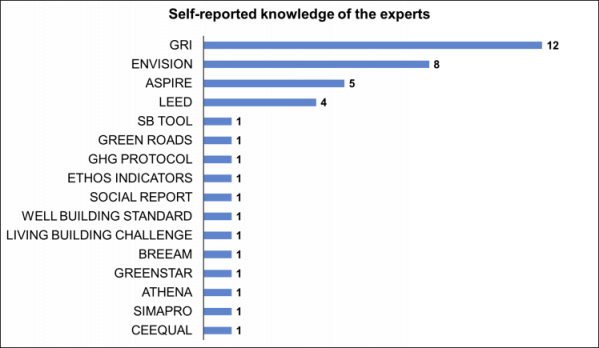
Figure 02 – Self-reported knowledge of the expert respondents of infrastructure sustainability models and tools
Table 1 shows the indicators which were considered essential by, at least, 18 specialists. To improve the measurement of the economic aspect, the economic indicators that came closest to the limit of the critical CVR were included: “economic benefits,” “durability of structures,” “cost of any relocation of people,” and “ecosystem rehabilitation cost.” The experts evaluated each indicator according to its relevance in measuring the sustainability of infrastructure projects (Appendix A). As determined using the Critical CVR proposed by Ayre and Scally [57], the minimum number of “essential” evaluations for each indicator is 18, considering that 25 specialists contributed to the research.
Figure 3 summarizes the evaluation of the essentiality of the indicators greater than 80%, considering the respondents’ professional area.
4. GRI Sector Disclosure Proposed for Infrastructure Projects
The objective of this research was to develop a sustainability assessment instrument for infrastructure projects that interlocks with the Global Initiative Reporting (GRI). As well as specific contents for other sectors that already exist—airport operators, electric utilities, oil and gas, event organizer and others—this study proposes infrastructure project-specific content. Considering that all specific contents must be utilized jointly with the GRI standard content, we compared the indicators resulting from this study with those used by the GRI at standard disclosures. By doing so, it was possible to note that some are already considered in the standard disclosures (Table 2).
Table 3 presents the specific infrastructure indicators that are not covered by the GRI standard disclosures, which together form the infrastructure sector disclosure proposed in the present report to interlock with the GRI. The indicators were listed following the standard used by GRI for its contents for specific sectors: the prefix “EC” is for economic indicators, the prefix “EN” is for environmental indicators, and the prefix “SO” is for social indicators. The economic indicators were placed first, followed by the environmental and social indicators, again according to the GRI standard.
Table 1. Infrastructure sustainability indicators which were considered essential by, at least, 18 specialists.
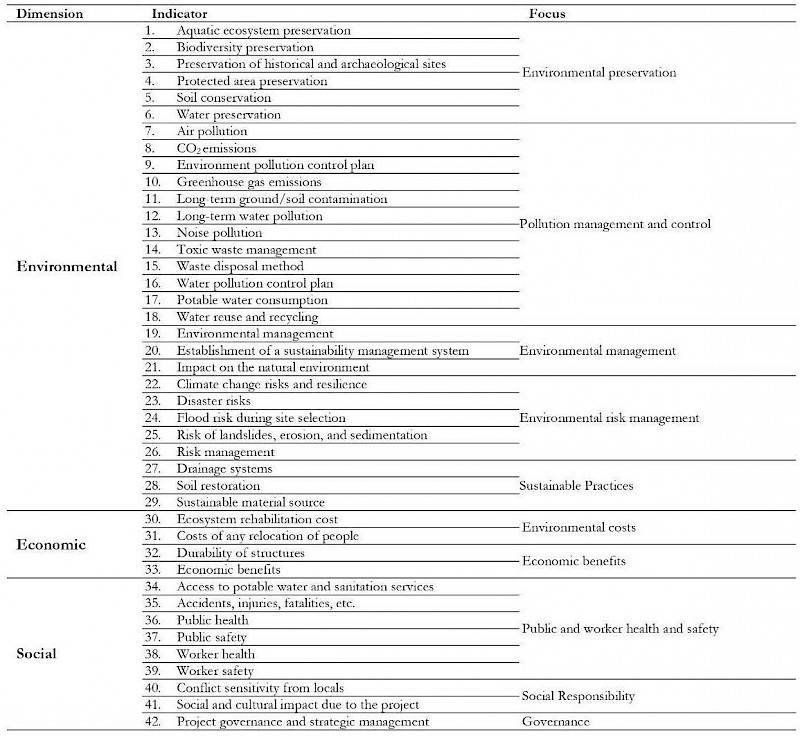
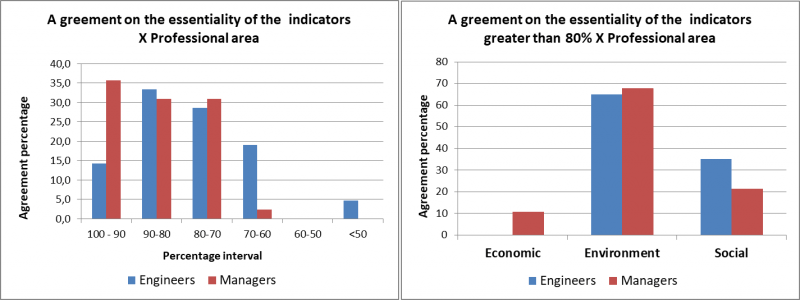
Fugure 03 – Evaluation on the essentiality of the indicators
Table 2. Indicators already considered in GRI-specific standard discolosures.
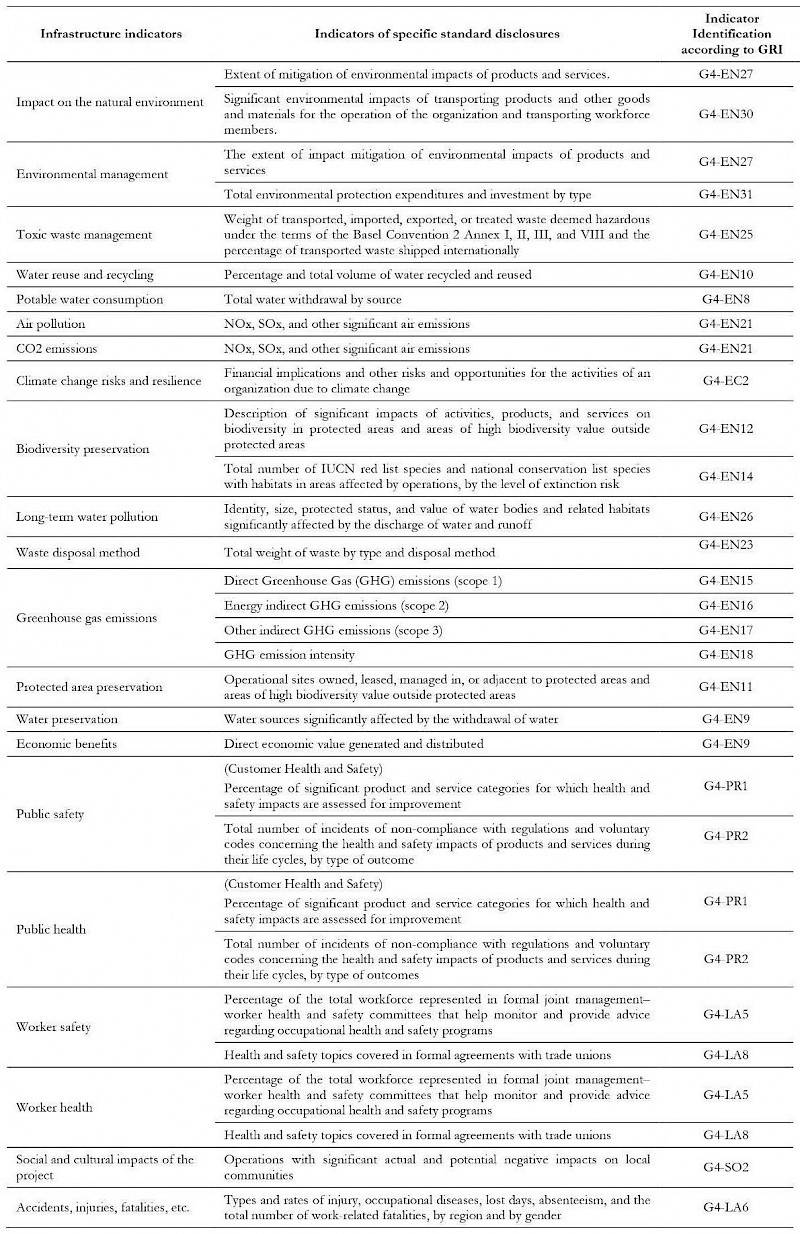
Table 3.Proposed infrastructure sector disclosure to interlock with the Global Reporting Initiative
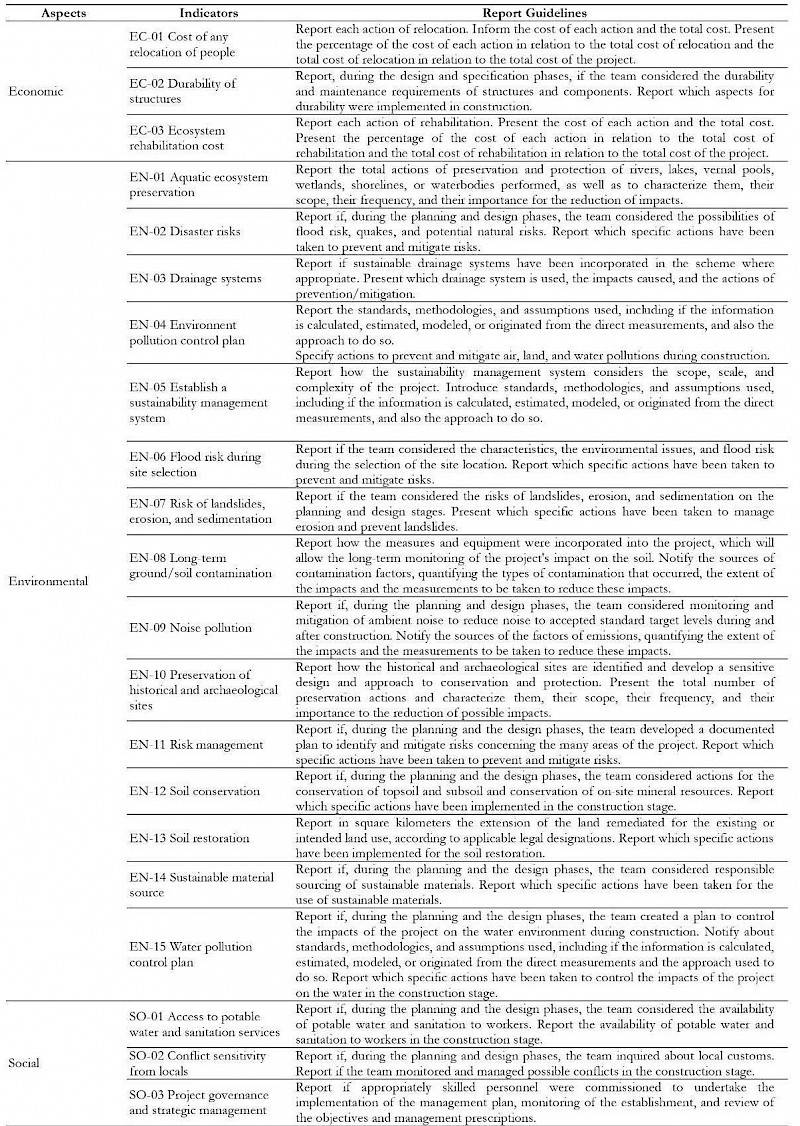
Figure 4 shows the number of indicators grouped by focus and Fig. 5 shows the number of indicators of the sustainability assessment tools grouped by the sustainability dimension.
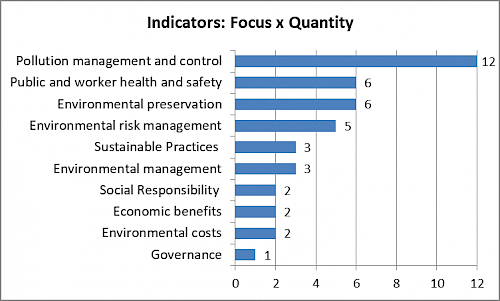
Figure 04 – Number of indicators grouped by focus.
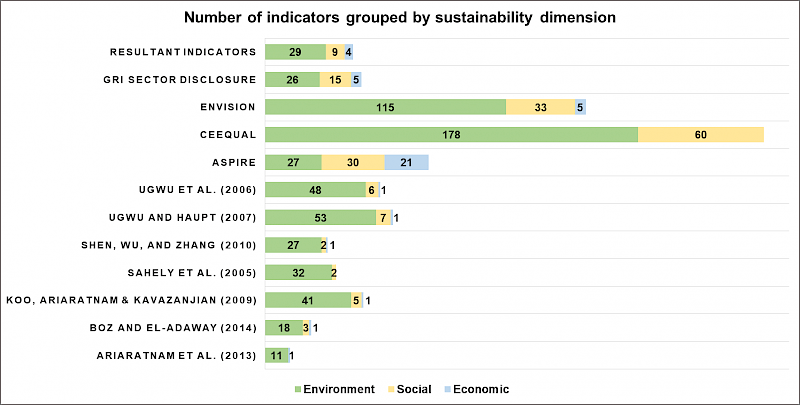
Figure 05 – umber of indicators of the sustainability assessment tools grouped by sustainability dimension.
5. Discussion
In general, environmental indicators are, to a greater or lesser extent, related to environmental health. More specifically, environmental indicators mainly reflect the concern with reducing pollution on the one hand and maximizing preservation on the other, essential and complementary actions in terms of the environmental health of a city or region.
Of the nine social indicators, six are directly related to public or worker health, demonstrating that an important aspect of social sustainability is related to how infrastructure projects impact the health of the people most directly affected by this type of project—people living in the neighborhood and the workers. Of the other social indicators, two are related to the project’s social responsibility to the affected community, and one represents the project’s governance issues, emphasizing the importance of project leadership for sustainability.
Two economic indicators involve environmental costs, and two involve economic benefits, of which one targets the economic benefits to the surrounding community arising from the project, and one measures the costs given the life cycle, durability, and maintenance of the project. The results show that the environmental aspect significantly influenced the judgment of the experts regarding the sustainability of infrastructure projects. The resulting indicators also reflected the tendency to utilize a higher proportion of environmental sustainability indicators, which is in agreement with previous studies [5, 14, 19, 22, 59, 60].
When we consider the indicators evaluated as essential (Table 1), analysis of Figure 3 shows that regarding the professional area, the assessment of managers concerning the essentiality was mainly between 70 and 90% of the indicators, and those of the engineers were between 70 and 100%. Only less than 5% of engineers assessed that less than 50% of the indicators are essential. When we consider the essentiality of the indicators above 80%, the analysis of Figure 3 shows that for the environmental dimension, the evaluation of engineers and managers was very similar, between 60 and 70%. Regarding the economic and social dimensions, the engineers did not attribute this essentiality to the economic indicators, giving greater emphasis to the social aspects.
One possible explanation for this result concerns the difference between professional activities. The engineer is responsible for the operationalization of the construction activities, which makes the environmental and social impacts more visible than the economic ones. Besides, it is common to find as a characteristic of the engineer’s profile, that of being able to understand the impact of engineering solutions in the socio-environmental context. In the project management environment, the factors of scope, time, and cost are conflicting and interdependent. They must be balanced by the project manager for the project success, which is why they are called Triple Constraint. Thus, the cost factor is more present in the activities of managers than in that of engineers.
These analyses show that the economic indicators are still a controversial aspect and are little explored in the field of sustainability indicators in infrastructure projects, which is confirmed by Boz & El-adaway [19]. Also, environmental indicators tend to be considered more critical than others.
Analysis of the indicators considered essential for engineers and managers reveals a significant presence of indicators linked to risk management: flood risk during site selection; risk management; climate change risks and resilience, risk of landslides, erosion, and sedimentation; and disaster risks, which is in agreement with the literature that states the high level of risk involving infrastructure projects due to their extension and impact [3, 12,13, 61].
Figure 4 shows that the 42 indicators can be grouped according to their focus on ten themes, of which Pollution management and control (29%), Environmental preservation (14%), and Public and worker health and safety (14 %) contains more than 50% of the indicators. In the discussions on sustainability, in general, these three themes have been widely discussed.
Comparing the essential indicators with other related instruments, it is possible to notice a considerable reduction in the number of indicators regarding ENVISION, CEEQUAL, ASPIRE, Ugwu et al. [13], and Ugwu and Haupt [9]. At the same time, the resulting indicators involve the environmental, economic and social aspects by following the holistic model of the Triple Bottom Line, with a better balance than ENSIVION, CEEQUAL, Ugwu, et al. [13], Ugwu and Haupt [10], Shen et al. [15], Sahely et al. [14], Koo et al. [24], Boz & El-Adaway [19] and Ariaratnam et al. [18]. Considering the number of indicators for the environmental, economic, and social aspects, the most balanced instrument in this scenario is ASPIRE, as shown in Figure 5.
When comparing the essential indicators with the sectoral contents of GRI “Construction and Real Estate”, it is possible to notice that specific indicators of infrastructure projects are missing in this sectorial content, such as noise pollution, toxic waste, preservation of historical and archaeological sites, disaster risks, climate change risks, flood risk during site selection, likelihood of landslides, erosion and sedimentation, access to potable water and sanitation services, drainage systems, life-cycle cost, and durability of structures.
This result is in agreement with the research of Liu et al. [62] that compared instruments intended to measure sustainability in construction projects in general and specific instruments for infrastructure projects. The authors conclude that particular aspects are covered only by tools of measurement in infrastructure projects, such as durability, benefits, landscape, humanities, culture, and creativity.
Considering that out of the 42 indicators that are considered essential 21 are already considered by the GRI, the data in Figure 6 show that most of the additional indicators added in GRI by the infrastructure sector disclosure are related to pollution management and control (8) and public and worker health and safety (5), representing 62% of the total additional indicators.
6. Conclusion
Due to their scale and nature, infrastructure projects can have significant environmental, social, and economic impacts. Aimed at evaluating the sustainability of these projects, several researchers have related indicators considered appropriate to this kind of analysis. However, the substantial increase in the number of infrastructure sustainability indicators introduces the risk that it might become too extensive. A significant problem related to the evaluation process through indicators is to identify sustainability indicators and to select an indicator set.
At the same time, there are specific aspects of infrastructure projects that are not covered by the indicators of sustainability-reporting instruments for construction in general. Also, there are no reports that identify the indicators that must be included in the GRI to improve aspects related to the environmental, social, and economic health of infrastructure projects. This study addresses these gaps.

Figure 6. Amount added to the GRI indicators by the infrastructure sector disclosure for each focus of approach
At the same time, there are specific aspects of infrastructure projects that are not covered by the indicators of sustainability-reporting instruments for construction in general. Also, there are no reports that identify the indicators that must be included in the GRI to improve aspects related to the environmental, social, and economic health of infrastructure projects. This study addresses these gaps
As for the goal of identifying the indicators of evaluating the sustainability of infrastructure projects considered the most important by researchers who publish on the topic, the strategy of focusing on the indicators with broader bibliographical support that concentrates the scope of research to increase the concentration of the respondents and consequently the quality of answers was adopted. After extensive analysis to eliminate redundancies, the result was a relation containing 97 indicators considered by researchers as suitable for the evaluation of infrastructure sustainability. This summary of indicators is an important contribution to the literature on the subject.
The results show that the environmental aspect significantly influenced the judgment of the experts regarding the sustainability of infrastructure projects, and, in general, environmental indicators are, to a greater or lesser extent, related to environmental health. Regarding the goal of identifying indicators that can be considered essential, following an experts’ opinion survey, we found that 42 indicators may be considered essential to assess the sustainability of the infrastructure projects. The possibility of reducing the number of indicators to be evaluated, considering only the essential ones, is an important contribution for professionals in the area
As for the objective to propose a specific set of indicators that enable the inclusion in the GRI project sustainability reports of a specific sector to assess the sustainability of the infrastructure projects, using the relation of the indicators considered essential as its basis, we found the need to add 21 indicators.
Considering the importance of the GRI project sustainability reports in international sustainability assessment, this paper contributes to the evaluation of infrastructure project sustainability, proposing a GRI infrastructure sector disclosure.
The results show that of the 21 indicators proposed for the infrastructure sector disclosure, eight are related to pollution management and control, and five are related to public and worker health and safety. The results also show that economic indicators are still a controversial aspect and are little explored in the field of sustainability indicators in infrastructure projects, agreeing with other researchers’ work on the theme.
The comparison of the indicators considered essential to the other related instruments in this study shows a significant reduction in the number of indicators, involving environmental, economic, and social aspects by following the holistic model of the Triple Bottom Line.
This study has a typical research limitation based on the literature review. Although extensive and detailed bibliographic research was conducted, the possibility remains that something important may not have been studied. Also, It is important to stress that by focusing on fewer indicators, it is possible that indicators that are relevant to specific realities, depending on the location and characteristics of the infrastructure project, may not be considered.
To improve the results of this research, we have two suggestions. The first is to conduct a survey with specialists in infrastructure projects to identify other economic and social indicators based on the experience of these professionals, since in the literature on the subject, there are few references to this type of indicator. The second is to use the set of identified indicators in real cases of infrastructure projects to assess the needs for improvement concerning their effectiveness for the dissemination of sustainability aspects. However, we recognize that this will be a time-consuming process, considering the deadlines usually demanded by this type of project. We hope that future developments of this research will encourage other researchers to identify and quantify the impacts of infrastructure projects.
Acknowledgments.
The authors would like to thank Universidade Federal Fluminense, Brazil, for funding the research reported in this paper. The authors would like to thank all the experts who answered the survey. The authors also express their gratitude to the editor and anonymous reviewers for comments and suggestions.
Conflicts of Interest.
The authors declare no conflict of interest.
References
[1] W. Jiradamkerng, “Productivity Management of Road Construction in Thailand by EZStrobe Simulation System—Case Study: 0.15 m. Thick Subbase Course Construction,” Eng. J., vol. 20, no. 3, pp. 184-195, 2016. [2] F. Pardo-Bosch, A. Aguado, “Sustainability as the key to prioritize investments in public infrastructures,” Environmental Impact Assessment Review, vol. 60, pp. 40–51, 2016..
[3] S. Dasgupta, E. K. Tam, “Indicators and framework for assessing sustainable infrastructure,” Canadian Journal of Civil Engineering, vol. 32, no. 1, pp. 30–44, 2005.
[4] J. Han, W. N. Xiang, “Analysis of material stock accumulation in China’s infrastructure and its regional disparity,” Sustainability science, vol. 8, no. 4, pp. 553-564, 2013..
[5] R. Y. J. Siew, M. C. A. Balatbat, and D. G. Carmichael, “A review of building/infrastructure sustainability reporting tools (SRTs),” Smart and Sustainable Built Environment, vol. 2, no. 2, pp. 106–139, 2013.
[6] A. V. Mansur, E. S. Brondízio, S. Roy, S. Hetrick, N. D. Vogt, and A. Newton, “An assessment of urban vulnerability in the Amazon Delta and Estuary: a multi-criterion index of flood exposure, socio-economic conditions and infrastructure,” Sustainability Science, vol. 11, no. 4, pp. 625-643, 2016.
[8] A.L. Brown and I. Van Kamp, “WHO Environmental Noise Guidelines for the European Region: A Syst[7] Y. Sawada, “The Impacts of Infrastructure in Development: A Selective Survey,” ADBI Working Paper 511. Tokyo: Asian Development Bank Institute, 2015. [Online]. Available: http://www.adbi.org/working-paper/2015/01/20/6526.impacts.infrastructure.in.dev/.
[8] A.L. Brown and I. Van Kamp, “WHO Environmental Noise Guidelines for the European Region: A Systematic Review of Transport Noise Interventions and Their Impacts on Health,” International Journal of Environmental Research and Public Health, vol. 14, pp. 1-39, 2017.
[9] A. Riley-Powell, G. Lee, N. Naik, K. Jensen, C.O’Neal, G. Salmón-Mulanovich, S.M. Hartinger, D.G. Bausch, and V. Paz-Soldan, “The impact of road construction on subjective well-being in communities in Madre de Dios, Peru,” International Journal of Environmental Research and Public Health, vol. 15, no. 6, pp. 1-16, 2018.
[10] K. Udomsilp, T. Arayakarnkul, S. atarakitpaisarn, P. Komolkiti, J. Rudjanakanoknad, and C. swakul, “Traffic Data Analysis on Sathorn Road with Synchro Optimization and Traffic Simulation”, Eng. J., vol. 21, no. 6, pp. 57-67, 2017..
[11] S. R. Januchowski-Hartley, C. Jézéquel, and P. A. Tedesco, “Modelling built infrastructure heights to evaluate common assumptions in aquatic conservation,” Journal of Environmental Management, vol. 232, pp. 131-137, 2019..
[12] O. O. Ugwu and T. C. Haupt, “Key performance indicators and assessment methods for infrastructure sustainability-A South African construction industry perspective,” Building and Environment, vol. 42, no.2, pp. 665-680, 2007.
[13] O. O. Ugwu, M. M. Kumaraswamy, A. Wong, and S. T. Ng, “Sustainability appraisal in infrastructure projects (SUSAIP): Part 1. Development of indicators and computational methods,” Automation in Construction, vol. 15, no.2, pp. 239-251, 2006..
[14] H. R. Sahely, C. A. Kennedy, and B. J. Adams, “Developing sustainability criteria for urban infrastructure systems,” Canadian Journal of Civil Engineering, vol. 32, no.1, pp. 72–85, 2005.
[15] L.Shen, Y. Wu, and X. Zhang, “Key assessment indicators for the sustainability of infrastructure projects,” Journal of Construction Engineering and Management, vol. 137, no. 6, pp. 441–451, 2010..
[16] C. Dyer, C. Luebkeman, and A. Guthrie, “A profitable and resource efficient future: Catalyzing retrofit finance and investing in commercial real estate,” In World Economic Forum, Geneva, Switzerland, 201n [17] A. K. Surjan, and R. Shaw, “‘Eco-city’ to ‘disaster-resilient eco-community’: a concerted approach in the coastal city of Puri, India,” Sustainability Science, vol. 3, no. 2, pp. 249-265, 2008.
[18] S. T. Ariaratnam, K. Piratla, A. Cohen, and M. Olson, “Quantification of sustainability index for underground utility infrastructure projects,” Journal of Construction Engineering and Management, vol. 139, no. 12, pp. 1-9, 2013..
[19] M. A. Boz and I. H. El-adaway, “Creating a holistic systems framework for sustainability assessment of civil infrastructure projects,” Journal of Construction Engineering and Management, vol. 141, no. 2, pp. 1-11, 2014.
[20] I. Degert, P. Parikh, and R. Kabir, “Sustainability assessment of a slum upgrading intervention in Bangladesh,” Cities, vol. 56, pp. 63–73, 2016..
[21] A. Schweikert, X. Espinet, and P. Chinowsky, “The triple bottom line: bringing a sustainability framework to prioritize climate change investments for infrastructure planning,” Sustainability Science, vol. 13, no. 2, pp. 377-391, 2018..
[22] T. Yigitcanlar and F. Dur, “Developing a sustainability assessment model: The sustainable infrastructure, land-use, environment, and transport model,” Sustainability, vol. 2, no. 1, pp. 321–340, 2010.
[23] G. Fernández-Sánchez and F. Rodríguez-López, “A methodology to identify sustainability indicators in construction project management—Application to infrastructure projects in Spain,” Ecological Indicators, vol. 10, no. 6, pp. 1193-1201, 2010..
[24] D. H. Koo, S. T. Ariaratnam, and E. Kavazanjian, “Development of a sustainability assessment model for underground infrastructure projects,” Canadian Journal of Civil Engineering, vol. 36, no. 5, pp. 765–776, 2009.
[25] T. Rogmans, and M. Ghunaim, “A framework for evaluating sustainability indicators in the real estate industry,” Ecological Indicators, vol. 66, pp. 603-611, 2016.
[26] V. Klevas, D. Streimikienea, and A. Kleviene, “Sustainability assessment of the energy projects implementation in regional scale,” Renewable and Sustainable Energy Reviews, vol. 13, no. 1, pp. 155-166, 2009.
[27] H. Rosenthal, “Sustainability assessment and indicator development: The electricity system in Dalian, China (master’s thesis),” Univ. of Waterloo, Waterloo, ON, Canada, 2004.
[28] C. M. Jeon, and A. Amekudzi, “Addressing sustainability in transportation systems: Definitions, indicators, and metrics,” Journal of Infrastructure Systems, vol. 11, no. 1, pp. 31-50, 2005.
[29] W. Ottevanger, M. Deimel, and K. S. V. Gendt, “Infrastructure planning-the environmental impact assessment for a Netherlands-Germany rail link,” Impact Assessment and Project Appraisal, vol. 18, no. 1, pp. 77-85, 2000.
[30] M. Lundin and G. M. Morrison, “A life cycle assessment based procedure for the development of environmental sustainability indicators for urban water systems,” Urban Water, vol. 4, no. 2, pp. 145-152, 2002.
[31] Arup & Engineers Against Poverty, “A sustainability, poverty and infrastructure routine for evaluation (ASPIRE),” Research and development, London, United Kingdom, 2009.
[32] CEEQUAL, Assessment manual for projects in the UK .Ireland. Watford, England, 2010.
[33] Institute for Sustainable Infrastructure. “ENVISION: Rating system for sustainable infrastructure”. Washington, USA, 2015
[34] GRI, “Construction and real estate: Sector disclosures,” Amsterdam: Global Reporting Initiative, 2014.
[35] C. A. Adams and G. R. Frost, “Integrating sustainability reporting into management practices”. Accounting Forum, vol. 32, no. 4, pp. 288–302, 2008.
[36] J. Bebbington, J. Brown, and B. Frame, “Accounting technologies and sustainability assessment models,” Ecological Economics, vol. 61, no. 2–3, pp. 224–236, 2007.
[37] J. Bebbington and R. Gray, “An account of sustainability: Failure, success and a reconceptualization,” Critical Perspectives on Accounting, vol. 12, no. 5, pp. 557–587, 2001.
[38] M. J. Jones, “Accounting for the environment: Towards a theoretical perspective for environmental accounting and reporting,” Accounting Forum, vol. 34, no. 2, pp. 123–138, 2010.
[39] J. Pope, D. Annandale, and A. Morrison-Saunders, “Conceptualizing sustainability assessment,” Environmental Impact Assessment Review, vol. 24, no. 6, pp. 595–616, 2004.
[40] J. Bebbington, C. Larrinaga, and J. M. Moneva, “Corporate social reporting and reputation risk management,” Accounting, Auditing and Accountability Journal, vol. 21, no. 3, pp. 337–361, 2008.
[41] A. R. Belal, “Stakeholder accountability or stakeholder management: A review of UK firms social and ethical accounting, auditing and reporting (SEAAR) practices,” Corporate Social Responsibility and Environmental Management, vol. 9, no. 1, pp. 8–25, 2002.
[42] G. Georgakopoulos and I. Thomson, “Social reporting, engagements, controversies and conflict in an arena context,” Accounting, Auditing and Accountability Journal, vol. 21, no. 8, pp. 1116–1143, 2008.
[43] A. L. Dahl, “Achievements and gaps in indicators for sustainability,” Ecological Indicators, vol. 17, pp. 14–19, 2012.
[44] R. Hueting and L. Reijnders, “Broad sustainability contra sustainability: The proper construction of sustainability indicators,” Ecological Economics, vol. 50, no. 3, pp. 249–260, 2004
[45] V. Lesic, R.E. Hodgett, A. Pearman, and A. Peace, “How to Improve Impact Reporting for Sustainability,” Sustainability, vol. 11, pp. 1-21, 2019.
[46] D. Giacomini, L. Rocca, C. Carini, and M. Mazzoleni, “Overcoming the Barriers to the Diffusion of Sustainability Reporting in Italian LGOs: Better Stick or Carrot?,” Sustainability, vol. 10, pp. 1-14, 2018.
[47] A.A.S. Batista and A.C. Francisco, “Organizational Sustainability Practices: A Study of the Firms Listed by the Corporate Sustainability Index,” Sustainability, vol, 10, pp. 1-13, 2018.
[48] F. Marimon, M. del Mar Alonso-Almeida, M. del Pilar Rodríguez, and K. A. C. Alejandro, “The worldwide diffusion of the global reporting initiative: What is the point?,” Journal of Cleaner Production, vol. 33, pp. 132–144, 2012.
[49] M. Milne and R. Gray, “W(h)ither ecology? The triple bottom line, the Global Reporting Initiative, and corporate sustainability reporting,” Journal of Business Ethics, vol. 118, no. 1, pp. 13–29, 2012.
50] R. Nikolaeva and M. Bicho, “The role of institutional and reputational factors in the voluntary adoption of corporate social responsibility reporting standards,” Journal of the Academy of Marketing Science, vol. 39, no. 1, pp. 136–157, 2011.
[51] L. Vigneau, M. Humphreys, and J. Moon, “How do firms comply with international sustainability standards? Processes and consequences of adopting the Global Reporting Initiative,” Journal of Business Ethics, vol. 131, no. 2, pp. 469–486, 2015.
[52] A. Willis, “The role of the Global Reporting Initiative’s sustainability reporting guidelines in the social screening of investments,” Journal of Business Ethics, vol. 43, no. 3, pp. 233–237, 2004.
[53] GRI, “Reporting principles and standard disclosures,” Amsterdam: Global Reporting Initiative, 2013.
[54] J. Webster and R. T. Watson, “Analyzing the past to prepare for the future: Writing a literature review,” MIS Quarterly, vol. 26, pp. 11–23, 2002.
[55] N. Gudienė, A. Banaitis, V. Podvezko, and N. Banaitienė, “Identification and evaluation of the critical success factors for construction projects in Lithuania: AHP approach,” Journal of Civil Engineering and Management, vol. 20, no. 3, pp. 350–359, 2014.
[56] C. H. Lawshe, “A quantitative approach to content validity,” Personnel Psychology, vol. 28, no. 4, 563–566, 1975.
[57] C. Ayre and A. J. Scally, “Critical values for Lawshe’s content validity ratio: Revisiting the original methods of calculation,” Measurement and Evaluation in Counseling and Development, 47, no. 1, pp. 79–86, 2014.
[58] L. J. Cronbach, “Coefficient alpha and the internal structure of tests,” Psycometrika, vol. 16, no. 3, pp. 297–334, 1951.
[59] A. Fricker, “Measuring up to sustainability,” Futures, vol. 30, no. 4, pp. 367–375, 1998.
[60] A. G. Silvius and R. Schipper, “A maturity model for integrating sustainability in projects and project management,” In 24th World Congress of the International Project Management Association (IPMA) Istanbul, Turkey, 2010.
[61] T. Quinn, F. Bousquet, C. Guerbois, L. Heider, and K. Brown, “How local water and waterbody meanings shape flood risk perception and risk management preferences,” Sustainability Science, vol. 14, no. 30, pp. 565–578, 2019.
[62] T. Y. Liu, P. H. Chen, and N. N. Chou, “Comparison of Assessment Systems for Green Building and Green Civil Infrastructure,” Sustainability, vol. 11, no. 7, pp. 1-22, 2019.
Appendix A. Data collection instrument containing Infrastructure sustainability indicators resulting from bibliographic research.
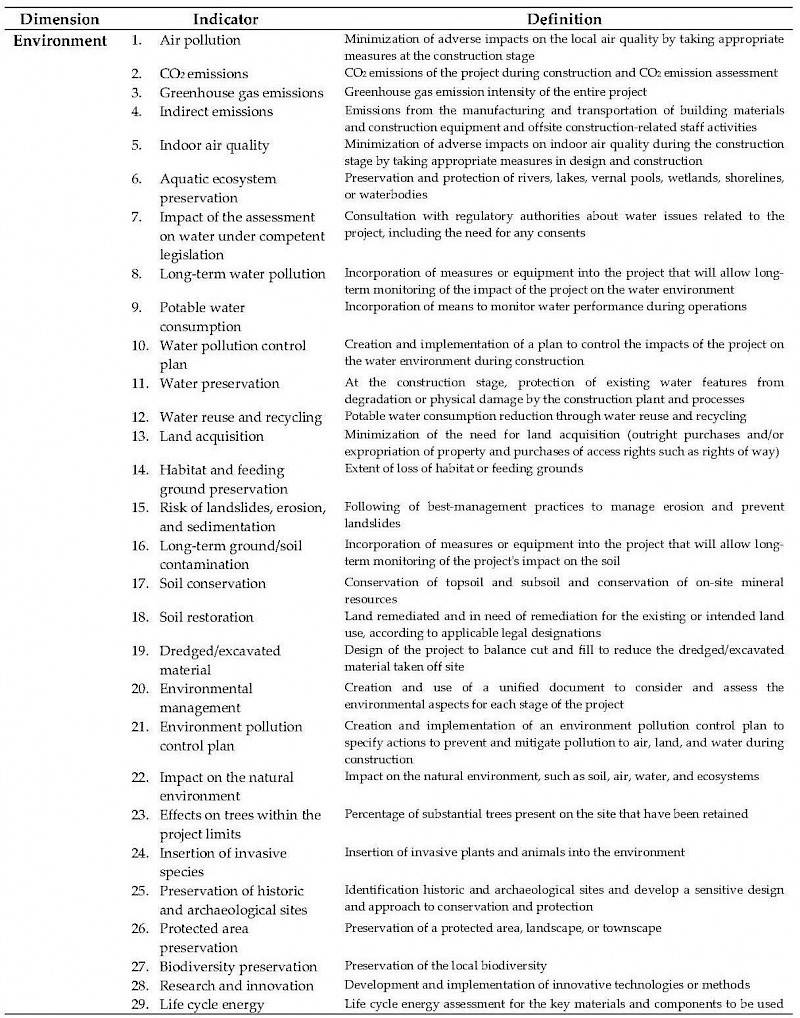
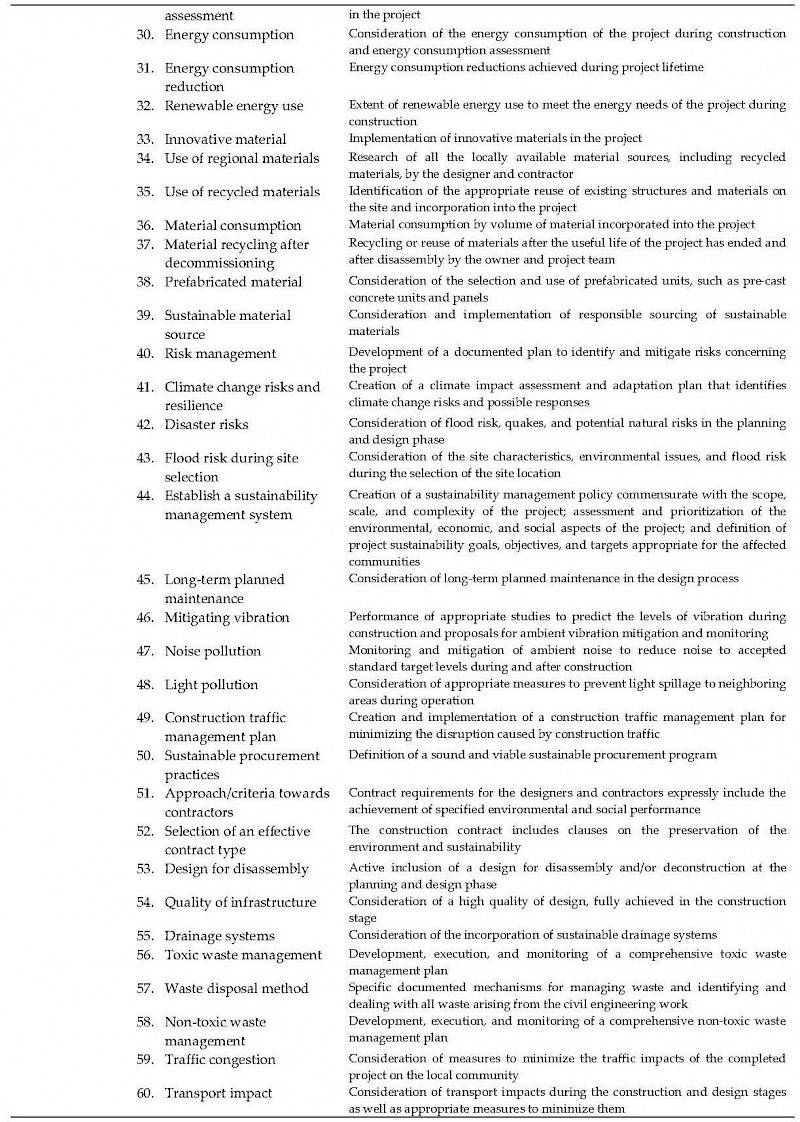
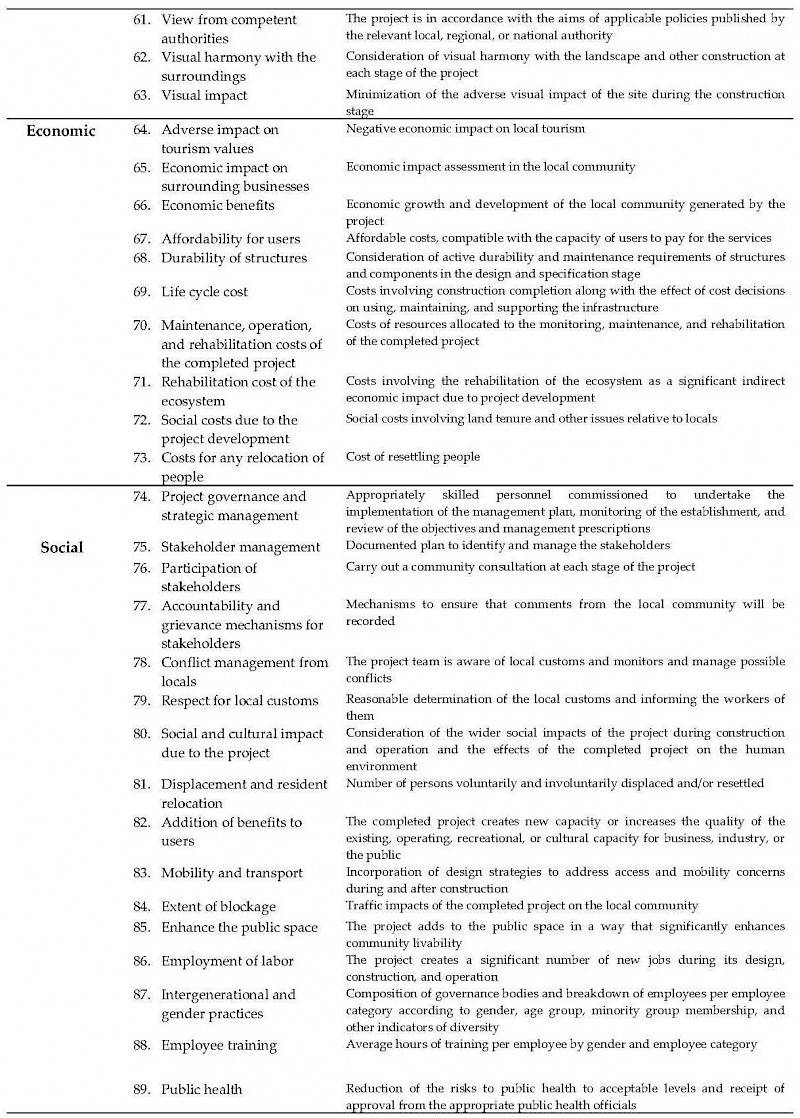
Project , Sustainability , Project Indicators